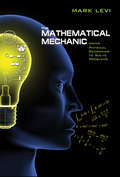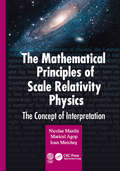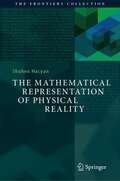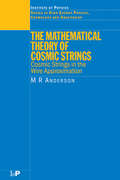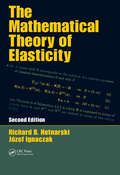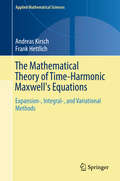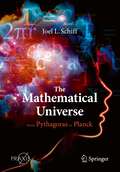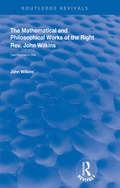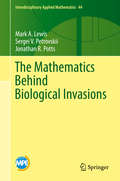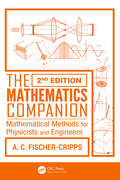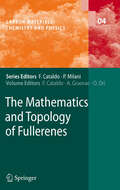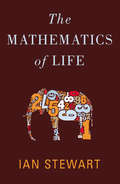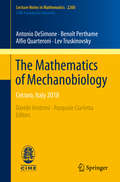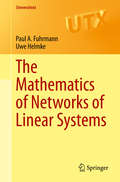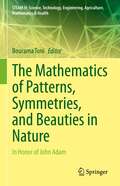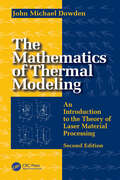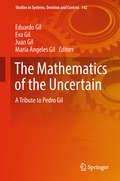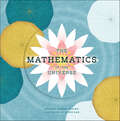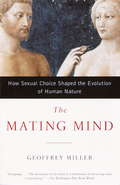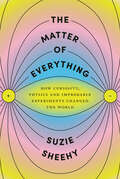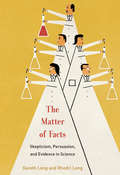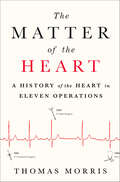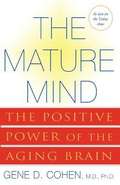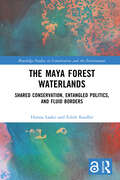- Table View
- List View
The Mathematical Mechanic
by Mark LeviEverybody knows that mathematics is indispensable to physics--imagine where we'd be today if Einstein and Newton didn't have the math to back up their ideas. But how many people realize that physics can be used to produce many astonishing and strikingly elegant solutions in mathematics? Mark Levi shows how in this delightful book, treating readers to a host of entertaining problems and mind-bending puzzlers that will amuse and inspire their inner physicist. Levi turns math and physics upside down, revealing how physics can simplify proofs and lead to quicker solutions and new theorems, and how physical solutions can illustrate why results are true in ways lengthy mathematical calculations never can. Did you know it's possible to derive the Pythagorean theorem by spinning a fish tank filled with water? Or that soap film holds the key to determining the cheapest container for a given volume? Or that the line of best fit for a data set can be found using a mechanical contraption made from a rod and springs? Levi demonstrates how to use physical intuition to solve these and other fascinating math problems. More than half the problems can be tackled by anyone with precalculus and basic geometry, while the more challenging problems require some calculus. This one-of-a-kind book explains physics and math concepts where needed, and includes an informative appendix of physical principles. The Mathematical Mechanic will appeal to anyone interested in the little-known connections between mathematics and physics and how both endeavors relate to the world around us.
The Mathematical Principles of Scale Relativity Physics: The Concept of Interpretation
by Ioan Merches Nicolae Mazilu Maricel AgopThe Mathematical Principles of Scale Relativity Physics: The Concept of Interpretation explores and builds upon the principles of Laurent Nottale’s scale relativity. The authors address a variety of problems encountered by researchers studying the dynamics of physical systems. It explores Madelung fluid from a wave mechanics point of view, showing that confinement and asymptotic freedom are the fundamental laws of modern natural philosophy. It then probes Nottale’s scale transition description, offering a sound mathematical principle based on continuous group theory. The book provides a comprehensive overview of the matter to the reader via a generalization of relativity, a theory of colors, and classical electrodynamics. Key Features: Develops the concept of scale relativity interpreted according to its initial definition enticed by the birth of wave and quantum mechanics Provides the fundamental equations necessary for interpretation of matter, describing the ensembles of free particles according to the concepts of confinement and asymptotic freedom Establishes a natural connection between the Newtonian forces and the Planck’s law from the point of view of space and time scale transition: both are expressions of invariance to scale transition The work will be of great interest to graduate students, doctoral candidates, and academic researchers working in mathematics and physics.
The Mathematical Representation of Physical Reality (The Frontiers Collection)
by Shahen HacyanThis book deals with the rise of mathematics in physical sciences, beginning with Galileo and Newton and extending to the present day. The book is divided into two parts. The first part gives a brief history of how mathematics was introduced into physics—despite its "unreasonable effectiveness" as famously pointed out by a distinguished physicist—and the criticisms it received from earlier thinkers. The second part takes a more philosophical approach and is intended to shed some light on that mysterious effectiveness. For this purpose, the author reviews the debate between classical philosophers on the existence of innate ideas that allow us to understand the world and also the philosophically based arguments for and against the use of mathematics in physical sciences. In this context, Schopenhauer’s conceptions of causality and matter are very pertinent, and their validity is revisited in light of modern physics. The final question addressed is whether the effectiveness of mathematics can be explained by its “existence” in an independent platonic realm, as Gödel believed.The book aims at readers interested in the history and philosophy of physics. It is accessible to those with only a very basic (not professional) knowledge of physics.
The Mathematical Theory of Cosmic Strings: Cosmic Strings in the Wire Approximation (Series in High Energy Physics, Cosmology and Gravitation)
by M.R. AndersonThis book is a comprehensive survey of the current state of knowledge about the dynamics and gravitational properties of cosmic strings treated in the idealized classical approximation as line singularities described by the Nambu-Goto action. The author's purpose is to provide a standard reference to all work that has been published since the mid-1
The Mathematical Theory of Elasticity
by Richard B. Hetnarski Jozef IgnaczakThrough its inclusion of specific applications, The Mathematical Theory of Elasticity, Second Edition continues to provide a bridge between the theory and applications of elasticity. It presents classical as well as more recent results, including those obtained by the authors and their colleagues. Revised and improved, this edition incorporates add
The Mathematical Theory of Time-Harmonic Maxwell's Equations
by Andreas Kirsch Frank HettlichThis book gives a concise introduction to the basic techniques needed for the theoretical analysis of the Maxwell Equations, and filters in an elegant way the essential parts, e. g. , concerning the various function spaces needed to rigorously investigate the boundary integral equations and variational equations. The book arose from lectures taught by the authors over many years and can be helpful in designing graduate courses for mathematically orientated students on electromagnetic wave propagation problems. The students should have some knowledge on vector analysis (curves, surfaces, divergence theorem) and functional analysis (normed spaces, Hilbert spaces, linear and bounded operators, dual space). Written in an accessible manner, topics are first approached with simpler scale Helmholtz Equations before turning to Maxwell Equations. There are examples and exercises throughout the book. It will be useful for graduate students and researchers in applied mathematics and engineers working in the theoretical approach to electromagnetic wave propagation.
The Mathematical Universe: From Pythagoras to Planck (Springer Praxis Books)
by Joel L. SchiffI first had a quick look, then I started reading it. I couldn't stop. -Gerard 't Hooft (Nobel Prize, in Physics 1999)This is a book about the mathematical nature of our Universe. Armed with no more than basic high school mathematics, Dr. Joel L. Schiff takes you on a foray through some of the most intriguing aspects of the world around us. Along the way, you will visit the bizarre world of subatomic particles, honey bees and ants, galaxies, black holes, infinity, and more. Included are such goodies as measuring the speed of light with your microwave oven, determining the size of the Earth with a stick in the ground and the age of the Solar System from meteorites, understanding how the Theory of Relativity makes your everyday GPS system possible, and so much more. These topics are easily accessible to anyone who has ever brushed up against the Pythagorean Theorem and the symbol π, with the lightest dusting of algebra. Through this book, science-curious readers will come to appreciate the patterns, seeming contradictions, and extraordinary mathematical beauty of our Universe.
The Mathematical and Philosophical Works of the Right Rev. John Wilkins (Routledge Revivals)
by John WilkinsOriginally published in 1708, this volume is an exact facsimile reproduction the 1802 edition of The Mathematical and Philosophical Works of the Right Rev. John Wilkins, and includes an index, added for the 1970 new impression. The book includes the works of Bishop John Wilkins, as well as a note on the life of the author; Bishop John Wilkins, as Warden of Wadham Colelge, Oxford and Master of Trinity College Cambridge, played a major role in the revitalization of British university education in the middle of the seventeenth century. Moreover, he was a prime mover in the establishment of the Royal Society of London and was its first secretary.
The Mathematics Behind Biological Invasions
by Mark A. Lewis Sergei V. Petrovskii Jonathan R. PottsThis book investigates the mathematical analysis of biological invasions. Unlike purely qualitative treatments of ecology, it draws on mathematical theory and methods, equipping the reader with sharp tools and rigorous methodology. Subjects include invasion dynamics, species interactions, population spread, long-distance dispersal, stochastic effects, risk analysis, and optimal responses to invaders. While based on the theory of dynamical systems, including partial differential equations and integrodifference equations, the book also draws on information theory, machine learning, Monte Carlo methods, optimal control, statistics, and stochastic processes. Applications to real biological invasions are included throughout. Ultimately, the book imparts a powerful principle: that by bringing ecology and mathematics together, researchers can uncover new understanding of, and effective response strategies to, biological invasions. It is suitable for graduate students and established researchers in mathematical ecology.
The Mathematics Companion: Mathematical Methods for Physicists and Engineers, 2nd Edition
by Anthony C. Fischer-CrippsEverything You Need to Know about Mathematics for Science and EngineeringUpdated and expanded with new topics, The Mathematics Companion: Mathematical Methods for Physicists and Engineers, 2nd Edition presents the essential core of mathematical principles needed by scientists and engineers. Starting from the basic concepts of trigonometry, the book
The Mathematics and Topology of Fullerenes
by Franco Cataldo Ottorino Ori Ante GraovacThe Mathematics and Topology of Fullerenes presents a comprehensive overview of scientific and technical innovations in theoretical and experimental studies. Topics included in this multi-author volume are: Clar structures for conjugated nanostructures; counting polynomials of fullerenes; topological indices of fullerenes; the wiener index of nanotubes; toroidal fullerenes and nanostars; C60 Structural relatives: a topological study; local combinatorial characterization of fullerenes; computation of selected topological indices of C60 and C80 Fullerenes via the Gap Program; 4valent- analogues of fullerenes; a detailed atlas of Kekule structures of C60. The Mathematics and Topology of Fullerenes is targeted at advanced graduates and researchers working in carbon materials, chemistry and physics.
The Mathematics of Life: The New Mathematics Of The Living World
by Ian StewartBiologists have long dismissed mathematics as being unable to meaningfully contribute to our understanding of living beings. Within the past ten years, however, mathematicians have proven that they hold the key to unlocking the mysteries of our world--and ourselves. In The Mathematics of Life, Ian Stewart provides a fascinating overview of the vital but little-recognized role mathematics has played in pulling back the curtain on the hidden complexities of the natural world--and how its contribution will be even more vital in the years ahead. In his characteristically clear and entertaining fashion, Stewart explains how mathematicians and biologists have come to work together on some of the most difficult scientific problems that the human race has ever tackled, including the nature and origin of life itself.
The Mathematics of Mechanobiology: Cetraro, Italy 2018 (Lecture Notes in Mathematics #2260)
by Benoît Perthame Alfio Quarteroni Lev Truskinovsky Antonio DeSimoneThis book presents the state of the art in mathematical research on modelling the mechanics of biological systems – a science at the intersection between biology, mechanics and mathematics known as mechanobiology. The book gathers comprehensive surveys of the most significant areas of mechanobiology: cell motility and locomotion by shape control (Antonio DeSimone); models of cell motion and tissue growth (Benoît Perthame); numerical simulation of cardiac electromechanics (Alfio Quarteroni); and power-stroke-driven muscle contraction (Lev Truskinovsky).Each section is self-contained in terms of the biomechanical background, and the content is accessible to all readers with a basic understanding of differential equations and numerical analysis. The book disentangles the phenomenological complexity of the biomechanical problems, while at the same time addressing the mathematical complexity with invaluable clarity. The book is intended for a wide audience, in particular graduate students and applied mathematicians interested in entering this fascinating field.
The Mathematics of Networks of Linear Systems
by Paul A. Fuhrmann Uwe HelmkeThis book provides the mathematical foundations of networks of linear control systems, developed from an algebraic systems theory perspective. This includes a thorough treatment of questions of controllability, observability, realization theory, as well as feedback control and observer theory. The potential of networks for linear systems in controlling large-scale networks of interconnected dynamical systems could provide insight into a diversity of scientific and technological disciplines. The scope of the book is quite extensive, ranging from introductory material to advanced topics of current research, making it a suitable reference for graduate students and researchers in the field of networks of linear systems. Part I can be used as the basis for a first course in Algebraic System Theory, while Part II serves for a second, advanced, course on linear systems. Finally, Part III, which is largely independent of the previous parts, is ideally suited for advanced research seminars aimed at preparing graduate students for independent research. "Mathematics of Networks of Linear Systems" contains a large number of exercises and examples throughout the text making it suitable for graduate courses in the area.
The Mathematics of Patterns, Symmetries, and Beauties in Nature: In Honor of John Adam (STEAM-H: Science, Technology, Engineering, Agriculture, Mathematics & Health)
by Bourama ToniThis unique book gathers various scientific and mathematical approaches to and descriptions of the natural and physical world stemming from a broad range of mathematical areas – from model systems, differential equations, statistics, and probability – all of which scientifically and mathematically reveal the inherent beauty of natural and physical phenomena. Topics include Archimedean and Non-Archimedean approaches to mathematical modeling; thermography model with application to tungiasis inflammation of the skin; modeling of a tick-Killing Robot; various aspects of the mathematics for Covid-19, from simulation of social distancing scenarios to the evolution dynamics of the coronavirus in some given tropical country to the spatiotemporal modeling of the progression of the pandemic. Given its scope and approach, the book will benefit researchers and students of mathematics, the sciences and engineering, and everyone else with an appreciation for the beauty of nature. The outcome is a mathematical enrichment of nature’s beauty in its various manifestations. This volume honors Dr. John Adam, a Professor at Old Dominion University, USA, for his lifetime achievements in the fields of mathematical modeling and applied mathematics. Dr. Adam has published over 110 papers and authored several books.
The Mathematics of Thermal Modeling: An Introduction to the Theory of Laser Material Processing, 2e
by John Michael DowdenThe Mathematics of Thermal Modeling, Second Edition, provides an introduction to the basics of the mathematics and physics needed to understand and use the physical principles employed in constructing models of a number of aspects of thermal modeling in industrial processes, notably laser welding; most of the techniques are applicable to many other technological processes, however.The book demonstrates how insight can be gained from mathematical enquiry at a simple level and helps workers understand the way in which more sophisticated models can be constructed. Some necessary but less familiar mathematical techniques are explained in greater detail than before and some discussion of wave-like features in welds is now included. An understanding will be gained of the importance of studying the interaction of multiple features.The book is equally suitable for engineers and material scientists at the Master's or first-year PhD level at university, to similar students with a background in mathematics or physics who are new to laser or industrial technology, or for research workers coming to mathematical modeling of industrial thermal processes for the first time, whatever stage they have reached in their career development.
The Mathematics of the Uncertain: A Tribute To Pedro Gil (Studies In Systems, Decision And Control #142)
by María Ángeles Gil Eduardo Gil Eva Gil Juan GilThis book is a tribute to Professor Pedro Gil, who created the Department of Statistics, OR and TM at the University of Oviedo, and a former President of the Spanish Society of Statistics and OR (SEIO). In more than eighty original contributions, it illustrates the extent to which Mathematics can help manage uncertainty, a factor that is inherent to real life. Today it goes without saying that, in order to model experiments and systems and to analyze related outcomes and data, it is necessary to consider formal ideas and develop scientific approaches and techniques for dealing with uncertainty. Mathematics is crucial in this endeavor, as this book demonstrates. As Professor Pedro Gil highlighted twenty years ago, there are several well-known mathematical branches for this purpose, including Mathematics of chance (Probability and Statistics),Mathematics of communication (Information Theory), andMathematics of imprecision (Fuzzy Sets Theory and others).These branches often intertwine, since different sources of uncertainty can coexist, and they are not exhaustive. While most of the papers presented here address the three aforementioned fields, some hail from other Mathematical disciplines such as Operations Research; others, in turn, put the spotlight on real-world studies and applications. The intended audience of this book is mainly statisticians, mathematicians and computer scientists, but practitioners in these areas will certainly also find the book a very interesting read.
The Mathematics of the Universe
by Soledad Romero MariñoThe lyrical verses and captivating illustrations of this picture book explore how the concepts and patterns of mathematics shape the natural world. The universe seems in such disarray, but it follows an order, not one thing astray. So the planets and stars have been created, atoms brought together as if they were fated. Nature's secrets are brought to life through an innovative blend of science, poetry, and art, making complex math concepts accessible and engaging for children aged five to nine. Young readers will discover the hidden mathematical patterns in everyday phenomena, from honeycombs and butterflies to celestial bodies and intricate geometric shapes. • This charming STEM educational resource encourages students to see the world through a mathematical lens. • Spheres, hexagons, symmetry, fractals, and spirals are among the concepts explored. • Each mathematical concept is presented alongside an observation, linking math to the universe's natural rhythms. • Thought-provoking quotes from renowned figures such as Galileo, Marcel Proust, and Jules Verne add depth to the learning experience. • The book’s large size, die-cut cover, and gorgeous art make it ideal for gifting and displaying.
The Mating Mind
by Geoffrey MillerAt once a pioneering study of evolution and an accessible and lively reading experience, The Mating Mind marks the arrival of a prescient and provocative new science writer. Psychologist Geoffrey Miller offers the most convincing-and radical-explanation for how and why the human mind evolved. Consciousness, morality, creativity, language, and art: these are the traits that make us human. Scientists have traditionally explained these qualities as merely a side effect of surplus brain size, but Miller argues that they were sexual attractors, not side effects. He bases his argument on Darwin's theory of sexual selection, which until now has played second fiddle to Darwin's theory of natural selection, and draws on ideas and research from a wide range of fields, including psychology, economics, history, and pop culture. Witty, powerfully argued, and continually thought-provoking, The Mating Mind is a landmark in our understanding of our own species.From the Trade Paperback edition.
The Matrix Perturbation Method in Quantum Mechanics
by Francisco Soto-Eguibar Braulio Misael Villegas-Martínez Héctor Manuel Moya-CessaThis book provides an alternative approach to time-independent perturbation theory in non-relativistic quantum mechanics. It allows easy application to any initial condition because it is based on an approximation to the evolution operator and may also be used on unitary evolution operators for the unperturbed Hamiltonian in the case where the eigenvalues cannot be found. This flexibility sets it apart from conventional perturbation theory. The matrix perturbation method also gives new theoretical insights; for example, it provides corrections to the energy and wave function in one operation. Another notable highlight is the facility to readily derive a general expression for the normalization constant at m-th order, a significant difference between the approach within and those already in the literature. Another unique aspect of the matrix perturbation method is that it can be extended directly to the Lindblad master equation. The first and second-order corrections are obtained for this equation and the method is generalized for higher orders. An alternative form of the Dyson series, in matrix form instead of integral form, is also obtained. Throughout the book, several benchmark examples and practical applications underscore the potential, accuracy and good performance of this novel approach. Moreover, the method's applicability extends to some specific time-dependent Hamiltonians. This book represents a valuable addition to the literature on perturbation theory in quantum mechanics and is accessible to students and researchers alike.
The Matter of Everything: How Curiosity, Physics, and Improbable Experiments Changed the World
by Suzie SheehyA surprising, fascinating journey through the experiments that not only unlocked the nature of matter and shaped our understanding of the cosmos but also forever changed the way we live within it"A book about the fundamental problems of physics written from a viewpoint I hadn&’t come across before: that of the experimenter. A splendid idea, vividly carried out.&” –Philip Pullman, best-selling author of His Dark MaterialsPhysics has always sought to deepen our understanding of the nature of matter and the world around us. But how do you conduct experiments with the fundamental building blocks of existence? How do you manipulate a particle a trillion times smaller than a grain of sand? How do you cause a proton to sail around a twenty-seven-kilometer-long loop 11,000 times per second? And, crucially, why is all this important?In The Matter of Everything, accelerator physicist Suzie Sheehy introduces us to the people who, through a combination of genius, persistence and luck, staged the experiments that changed the course of history. From the serendipitous discovery of X-rays in a German laboratory to the scientists trying to prove Einstein wrong (and inadvertently proving him right) to the race to split open the atom, these brilliant experiments led to some of the most significant breakthroughs in science and fundamentally changed our lives. They have helped us detect the flow of lava deep inside volcanoes, develop life-saving medical techniques like diagnostic imaging and radiation therapy, and create radio, TV, microwaves, smartphones—even the World Wide Web itself—among countless other advancements.Along the way, Sheehy pulls back the curtain to reveal how physics is really done—not only by theorists with equation-filled blackboards but also by experimentalists with hand-blown glass, hot air balloons and cathedral-sized electronics. Celebrating human ingenuity, creativity and above all curiosity, The Matter of Everything is an inspiring story of discovery and a powerful reminder that progress is a function of our desire to know.
The Matter of Facts: Skepticism, Persuasion, and Evidence in Science (The\mit Press Ser.)
by Gareth Leng Rhodri Ivor LengHow biases, the desire for a good narrative, reliance on citation metrics, and other problems undermine confidence in modern science.Modern science is built on experimental evidence, yet scientists are often very selective in deciding what evidence to use and tend to disagree about how to interpret it. In The Matter of Facts, Gareth and Rhodri Leng explore how scientists produce and use evidence. They do so to contextualize an array of problems confronting modern science that have raised concerns about its reliability: the widespread use of inappropriate statistical tests, a shortage of replication studies, and a bias in both publishing and citing “positive” results. Before these problems can be addressed meaningfully, the authors argue, we must understand what makes science work and what leads it astray. The myth of science is that scientists constantly challenge their own thinking. But in reality, all scientists are in the business of persuading other scientists of the importance of their own ideas, and they do so by combining reason with rhetoric. Often, they look for evidence that will support their ideas, not for evidence that might contradict them; often, they present evidence in a way that makes it appear to be supportive; and often, they ignore inconvenient evidence.In a series of essays focusing on controversies, disputes, and discoveries, the authors vividly portray science as a human activity, driven by passion as well as by reason. By analyzing the fluidity of scientific concepts and the dynamic and unpredictable development of scientific fields, the authors paint a picture of modern science and the pressures it faces.
The Matter of the Heart: A History of the Heart in Eleven Operations
by Thomas Morris“More than a litany of medical advances—it’s the story of the gritty, bloody and deadly experiences that underlie scientific progress.” —Washington PostAn eye-opening and heroic story of pioneering heart surgeons, structured around eleven operations.For thousands of years the human heart remained the deepest of mysteries; both home to the soul and an organ too complex to touch, let alone operate on.Then, in the late nineteenth century, medics began going where no one had dared go before. The following decades saw the mysteries of the heart exposed, thanks to pioneering surgeons, brave patients and even sacrificial dogs.In eleven landmark operations, Thomas Morris tells us stories of triumph, reckless bravery, swaggering arrogance, jealousy and rivalry, and incredible ingenuity: the trail-blazing ‘blue baby’ procedure that transformed wheezing infants into pink, healthy children; the first human heart transplant, which made headline news around the globe. And yet the heart still feels sacred: just before the operation to fit one of the first artificial hearts, the patient’s wife asked the surgeon if he would still be able to love her.The Matter of the Heart gives us a view over the surgeon’s shoulder, showing us the heart’s inner workings and failings. It describes both a human story and a history of risk-taking that has ultimately saved millions of lives.“A thoroughly engaging history.” —The Wall Street Journal“Morris’s expert guided tour of cardiac surgery and its quirky, brilliant innovators covers a dazzling and dizzying array of procedures and hints at tantalizing prospects for future surprises.” —Publishers Weekly, starred review“A well-developed narrative with no end of heroes.’“ —Kirkus Reviews“Gripping.” —John Crace, The Guardian
The Mature Mind: The Positive Power of the Aging Brain
by Gene D. CohenPsychological aspects of the aging brain
The Maya Forest Waterlands: Shared Conservation, Entangled Politics, and Fluid Borders (Routledge Studies in Conservation and the Environment)
by Hanna Laako Edith KaufferThis book examines the entanglements and blurred edges of nature conservation and geopolitical relations in the borderlands of the trinational Maya Forest.Maya Forest is an umbrella term for transboundary conservation developed by scientists and conservationists in the 1990s to protect the threatened rainforest in the borderlands of Mexico, Belize, and Guatemala. Currently, the Maya Forest is a biodiversity hotspot composed of a network of protected areas and heritage sites. However, issues related to water, land, and forests have often been treated as separate political units, and not as part of the same history. Written by two authors with decades of hands-on experience in this region, this book sheds light on the complex dynamics by which conservation and natural resource management geopolitically shape borderlands such as the Maya Forest. The book introduces the novel concept of forest waterlands as borderlands and fluid edges, which are now subject to concern by conservationists. These are entangled spaces in which conservation, peoples, and politics interact, connect, and disconnect with the nexus of waters, forests, and lands. The book sheds light on the building and mapping of the Maya Forest ecoregion, with particular attention to water as an often neglected, but unifying element. It showcases how the Maya Forest is a distinct region characterized by transformations entangled with the Maya, trails of biological stations, the shared history of chicleros (chewing-gum hunters), fluid international rivers and transboundary basins, and various geopolitical discrepancies. It offers a contemporary glimpse into the Maya Forest’s intertwined bio- and geopolitics, which urge us to rethink borders and boundaries.This book will be of great interest to students and scholars of nature conservation, global environmental politics, geopolitics, borderlands, international relations, and natural resource management.
